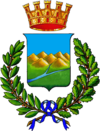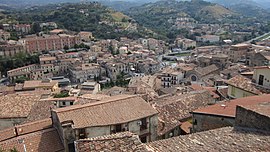Cosenza
| Cosenza | ||
|---|---|---|

|
|
|
| Country | Italy | |
| region | Calabria | |
| province | Cosenza (CS) | |
| Coordinates | 39 ° 18 ′ N , 16 ° 15 ′ E | |
| height | 238 m slm | |
| surface | 37 km² | |
| Residents | 66,457 (Dec. 31, 2019) | |
| Population density | 1,796 inhabitants / km² | |
| Factions | Borgo Partenope, Donnici, Sant'Ippolito | |
| Post Code | 87100 | |
| prefix | 0984 | |
| ISTAT number | 078045 | |
| Popular name | Cosentini | |
| Patron saint | Madonna del Pilerio | |
| Website | Cosenza | |
 View of the old town of Cosenza |
||
Cosenza ( Latin Consentia ) is the capital and the cultural center of the eponymous province in the region of Calabria in Italy with 66,457 inhabitants (December 31, 2019).
geography
Cosenza is located at the confluence of the Crati and Busento rivers at an altitude of 238 m at the foot of the Sila Mountains .
The distance to Catanzaro is 95 km and to Naples 315 km.
The neighboring municipalities are Aprigliano , Casali del Manco , Castrolibero , Dipignano , Mendicino , Paterno Calabro , Piane Crati , Pietrafitta , Rende , Rovito and Zumpano .
history
Cosenza, the ancient consentia , was founded in the 4th century BC. Founded by the tribe of the Bruttier (Bruttii) and was their capital. It is first mentioned in connection with the expedition of the Molossian king Alexander I of Epirus to southern Italy, who lived here in 330 BC. Was buried. During the Second Punic War , the city did not join the main part of the Grosser Hannibal at first, but soon had to surrender to the Carthaginian general Himilkon . Three years later, 213 BC. BC, Consentia appears among the allies of Rome , but later stood again on the side of the cities hostile to Rome and did not fall until 204 BC. Chr. Permanently to the Romans. It was heavily influenced by Greek culture. Cosentia is also mentioned as an important city on the occasion of the war Rome against Spartacus . During the Roman Civil Wars, Sextus Pompey besieged 40 BC. The city, but could not take it. She was known for her fruit and wine growing; the apple trees bore fruit twice a year. It developed into an economic center on the Via Popilia .
In the imperial era, ancient authors rarely mentioned consent. In 410 Alaric I , king of the Visigoths , is said to have died in Cosenza after the sack of Rome and was buried with his booty in the river bed of the Busento. The grave has not yet been found. August Graf von Platen wrote the ballad Das Grab im Busento about it in 1820 .
After the end of the Western Roman Empire, Cosenza fell to the Byzantines and was then heavily disputed between the Lombards and the Saracens . In the 7th century it became the seat of a diocese , which was elevated to an archbishopric in 1150. In the 11th century the city came under the rule of the Normans . In 1091 she revolted against Roger Guiscard , but was again subjected. Under the Hohenstaufen it was the seat of the Calabrian court. Subsequently, Cosenza offered bitter resistance to the rule of the Anjou . In 1461 it was conquered by Roberto Orsini and suffered severe damage. From 1500 it was under the control of Spain. From 1555 to 1561 it was the center of the persecution of the Waldensians , ordered by the Inquisition , who had settled here towards the end of the 14th century.
In 1707, the Austrians succeeded the Spaniards in rule over the Kingdom of Naples , which then fell to the Bourbons . In 1799 Cosenza belonged to the short-lived Parthenopean Republic and was recaptured for the Bourbons by Cardinal Ruffo . 1806-15 the city was under French hegemony. It was then part of the Kingdom of the Two Sicilies and the scene of several upheavals for Italian independence from Bourbon dominance. The high point was the unsuccessful uprising of 1844 by the Bandiera brothers , who were executed near Cosenza. In 1861 the city finally became part of the newly formed Kingdom of Italy .
Cosenza was repeatedly devastated by earthquakes , such as in 1181, 1638 and on February 4, 1783, where more than 30,000 people were killed and all older structures collapsed. It also suffered from the earthquakes of February 13, 1854 and October 4, 1870. Another earthquake shook the city in 1905. In World War II, Allied bombing heavy destruction directed in Cosenza.
traffic
Cosenza is on the Sibari –Cosenza railway and on the Catanzaro – Cosenza narrow-gauge line of the Ferrovie della Calabria (FC). In 1915 the Paola – Castiglione Cosentino cog railway was opened, which was replaced in 1987 by a new line with the Santomarco base tunnel. At the same time, the old terminal station was replaced by a new one.
Culture and sights
- The around 1100 in Romanesque - Gothic built style Cathedral (Cattedrale di Santa Maria Assunta) holds the tomb of the Roman-German king and king of Sicily Henry (VII.) From the sex of the Staufer , of the consequences of a fall from a horse at 12 He died February 1242 in Martirano and was buried here by his father, Emperor Friedrich II .
- One of the two tombs of the French Queen Isabella of Aragón , who died on the return journey from the Seventh Crusade on January 28, 1271 in Cosenza - also as a result of a fall from a horse - and was partially buried here , is also located in the cathedral.
- The ruins of the Castello Svevo, probably built by the Byzantines in the 5th century and rebuilt by Frederick II, lie on a hill .
- The theater built in 1887 in honor of the composer Alfonso Rendano , the city library and the Cafe Renzelli, which has existed since 1803, are well worth seeing.
- The Byzantine Italian-Greek-Albanian Santissimo Salvatore (in Arbëresh , IPA : [ ar'bəreʃ ] : Qisha Arbëreshe Kosenxë ) in Corso Plebiscito
Personalities
Sons and daughters of the town:
- Bernadino Telesio (1509–1588), philosopher
- Giovanni Battista Salerni (1670–1729), cardinal of the Roman Catholic Church
- Scipione Sersale (1691–1751), Bishop of Sora and Lecce
- Giuseppe Maria Sensi (1907–2001), cardinal of the Roman Catholic Church
- Francesco Leonetti (1924–2017), writer and poet
- Stefano Rodotà (1933–2017), lawyer, university professor and politician
- Mark Iuliano (* 1973), football player
- Stefano Fiore (* 1975), football player
- Damiano Quintieri (* 1990), football player
- Gianluca Marzullo (* 1991), football player
- Luca Garritano (* 1994), football player
Honorary citizen
- Serafino Sprovieri (1930–2018), Roman Catholic Archbishop of Benevento
literature
- Luca Addante: Cosenza ei cosentini. Un volo lungo tre millenni. Rubbettino Editore, Soveria Mannelli (Catanzaro) 2001, ISBN 88-498-0127-0 .
Web links
- Website of the city of Cosenza (Italian)
Individual evidence
- ↑ Statistiche demografiche ISTAT. Monthly population statistics of the Istituto Nazionale di Statistica , as of December 31 of 2019.
- ^ Strabon , Geographika 6, 256.
- ↑ Strabon, Geographika 6, 256; Titus Livius , Ab urbe condita 8, 24, 14 ff.
- ↑ Livy, Ab urbe condita 23, 30, 5;
- ^ Livy, Ab urbe condita 25, 1, 2; 28, 11, 13; 29, 38, 1; 30, 19, 10; Appian , Hannibalika 56.
- ↑ Lucilius in Cicero , De finibus 1, 7.
- ^ Orosius , Historiae adversus paganos 5, 24.
- ^ Appian, Civil Wars 5:56 and 5:58.
- ↑ Varro , De re rustica 1, 7, 6; Pliny , Naturalis historia 16, 69 and 16, 115.
- ↑ Jordanes , De origine actibusque Getarum 30.
- ↑ Cosenza , in: Heinrich August Pierer (Ed.): Universal-Lexikon der Gegenwart und Past , 4th edition, Vol. 4 (1857), p. 475.
- ^ Cosenza , in: Encyclopædia Britannica . 11th edition, 1910-11, Vol. 7, p. 213.
- ^ A b Cosenza , in: Encyclopædia Britannica online
- ^ Cosenza , in: Brockhaus' Konversations-Lexikon , 14th edition, 1892–96, Vol. 4, p. 539.





